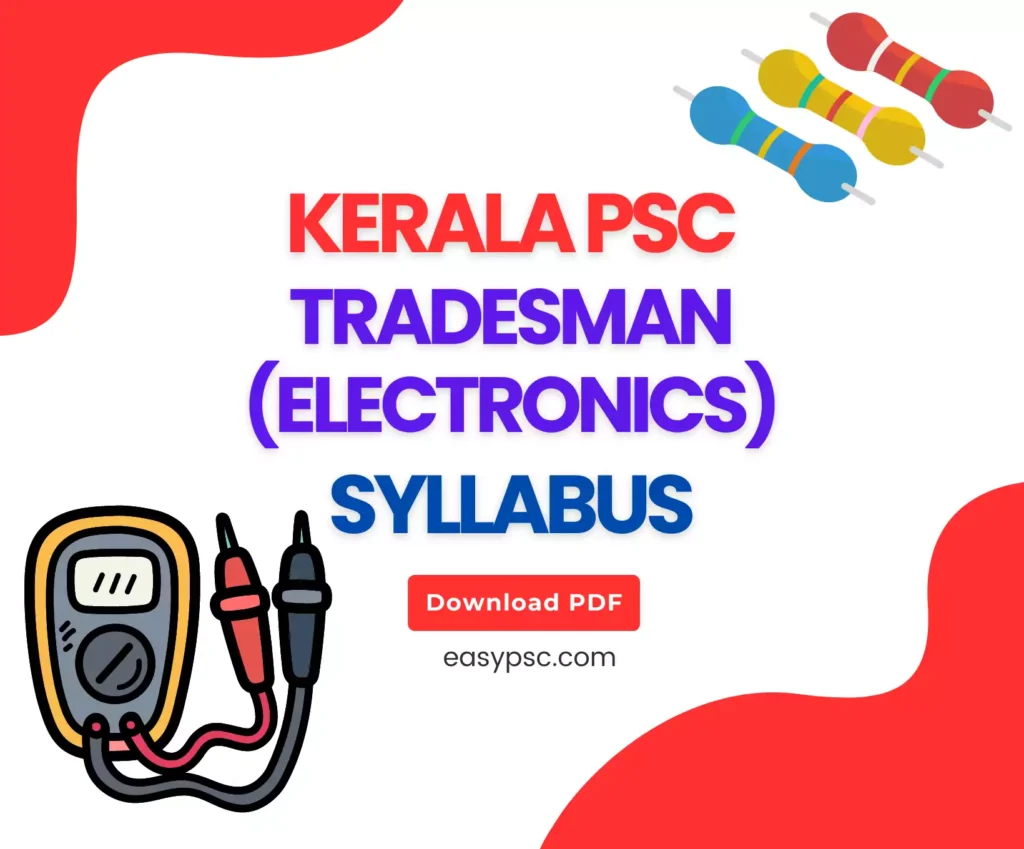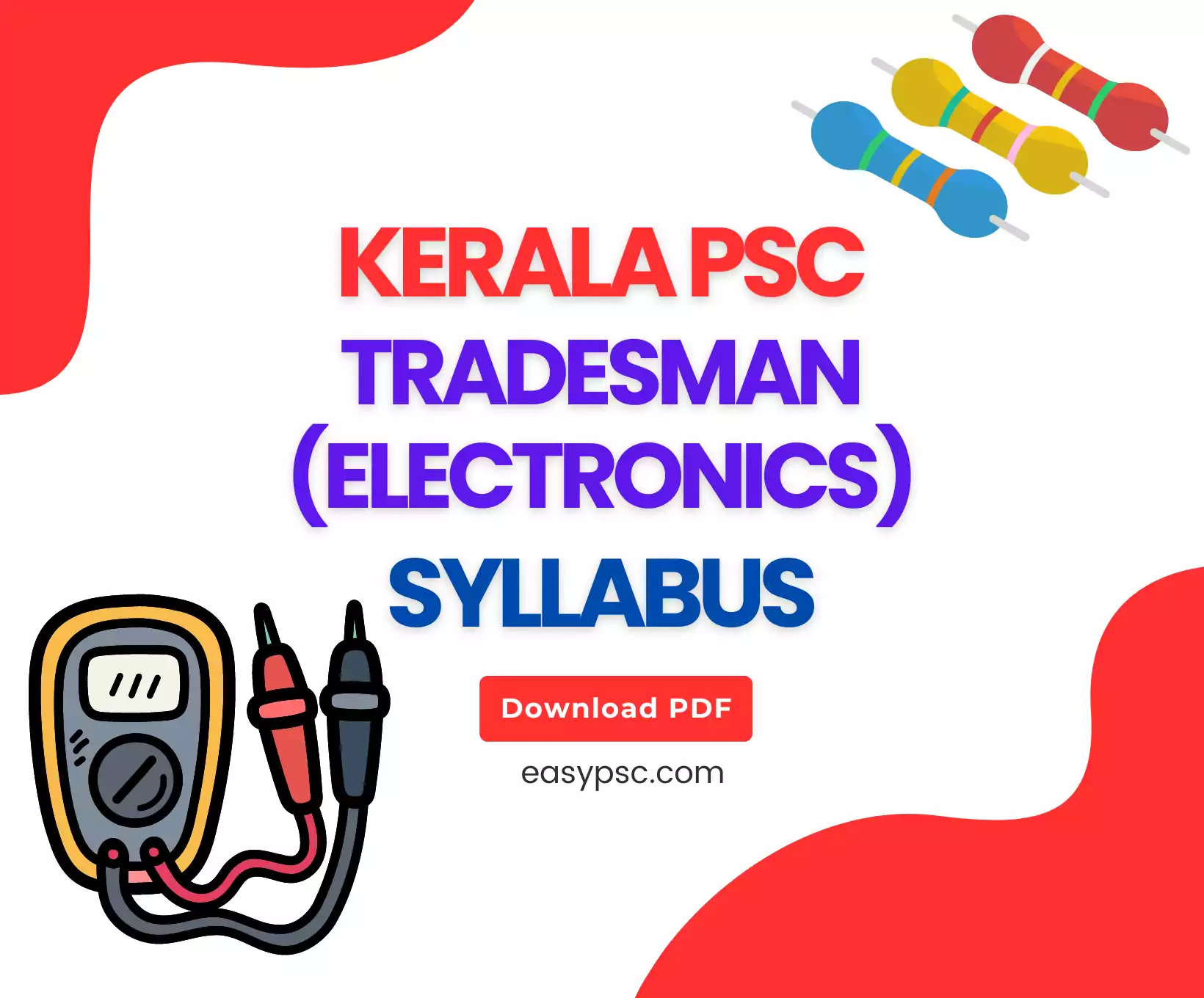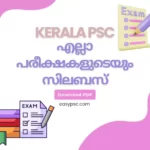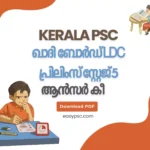
427/2023 – Tradesman (Electronics) Detailed Syllabus PDF: കേരള PSC 12 ഏപ്രിൽ 2024 ന് നടത്താൻ പോകുന്ന ട്രേഡ്സ്മാൻ (ഇലക്ട്രോണിക്സ്) (Tradesman (Electronics)) പരീക്ഷയുടെ വിശദമായ സിലബസ് പ്രസിദ്ധീകരിച്ചു. കാറ്റഗറി നംബർ 427/2023 ആണ്. ട്രെഡ്സ്മാൻ ഇലക്ട്രോണിക്സ് പരീക്ഷയുടെ സിലബസും പരീക്ഷാ പാറ്റേണും PDF രൂപത്തിൽ ഇവിടെ നിന്നും ഡൗൺലോഡ് ചെയ്ത് എടുക്കാവുന്നതാണ്. 22/01/2024 മുതൽ 10/02/2024 വരെ കൺഫോർമേഷൻ കൊടുക്കാവുന്നതാണ്. 27/03/2024 മുതൽ അഡ്മിഷൻ ടിക്കറ്റ് ലഭിക്കുന്നതായിരിക്കും. 12/04/2024 വെളളിയാഴ്ചയാണ് പരീക്ഷ നടക്കാൻ പോകുന്നത്. 100 മാർക്കിന്റെ OMR പരീക്ഷയാണ് വരുന്നത്. കൺഫിർമേഷൻ നൽകിയ സമയത്ത് സെലക്ട് ചെയ്ത ഭാഷയിലായിരിക്കും ചോദ്യ പേപ്പർ ലഭിക്കുക. വളരെ കൃത്യമായ ഒരു സിലബസ് കേരള PSC തന്നിട്ടുണ്ട്. സിലബസ് ഉപയോഗിച്ച് കൃത്യമായ പ്ലാനിങ്ങോടെ പഠിച്ചാൽ തീർച്ചയായും നിങ്ങൾക്ക് ഈ ജോലി ലഭിക്കുന്നതായിരിക്കും.
പ്രധാന വിവരങ്ങൾ
താഴെ കൊടുത്തിരിക്കുന്ന പട്ടികയിൽ നിന്നും കേരള PSC യുടെ Tradesman (Electronics) സിലബസിനെ പറ്റിയുള്ള എല്ലാ പ്രധാനപ്പെട്ട വിവരങ്ങളും ലഭിക്കുന്നതാണ്.
| പരീക്ഷ നടത്തുന്ന ഓർഗനൈസേഷൻ | കേരള പബ്ലിക് സർവീസ് കമ്മീഷൻ (KPSC) |
| കാറ്റഗറി | സിലബസ് |
| പരീക്ഷയുടെ പേര് | Tradesman (Electronics) |
| വകുപ്പ് | Technical Education |
| കാറ്റഗറി നംബർ | 427/2023 |
| വിഷയം | ട്രേഡ്സ്മാൻ (ഇലക്ട്രോണിക്സ്) സിലബസ് |
| പരീക്ഷ തിയ്യതിയും സമയവും | 12/04/2024 Friday |
| അഡ്മിഷൻ ടിക്കറ്റ് ലഭ്യമാകുന്ന തിയ്യതി | 27/03/2024 |
| ആകെ പരീക്ഷ എഴുതുന്നവർ | 16305 |
| ഒഫീഷ്യൽ വെബ്സൈറ്റ് | www.keralapsc.gov.in |
മാർക്ക് ഡിസ്ട്രിബ്യൂഷൻ
കേരള PSC Tradesman (Electronics) പരീക്ഷയുടെ മാർക്ക് ഡിസ്ട്രിബ്യൂഷൻ ഒന്ന് നോക്കാം. അതായത് ഓരോ ഭാഗത്ത് നിന്നും ലഭിക്കുന്ന മാർക്കിന്റെ വിവരങ്ങൾ. ഇത് മനസിലാക്കിയാൽ ഏത് ഭാഗത്തിന് കൂടുതൽ പ്രാധാന്യം കൊടുക്കണം, ഏത് ഭാഗം കൂടുതൽ ആഴത്തിൽ പഠിക്കണം എന്നൊക്കെ മനസിലാക്കാൻ സാധിക്കും.
| Module 1 | |
| Basics of AC, AC & DC measurements, and Active and Passive Components | 20 Mark |
| Module 2 | |
| Semiconductor materials, components | 22 Mark |
| Module 3 | |
| Amplifiers & Oscillators | 08 Mark |
| Module 4 | |
| Introduction to Digital Electronics | 15 mark |
| Module 5 | |
| Computer Hardware & Networking | 05 Mark |
| Module 6 | |
| Electrical protective devices and control circuits | 05 Mark |
| Module 7 | |
| Communication Electronics | 10 Mark |
| Module 8 | |
| Microcontroller (8051) | 05 Mark |
| Module 9 | |
| Sensors, Transducers, and Applications | 05 Mark |
| Module 10 | |
| SMPS, Inverter, UPS & Solar Power (Renewable Energy System) | 05 Mark |
വിശദമായ സിലബസ്
കേരള Tradesman (Electronics) പരീക്ഷയുടെ വിശദമായ സിലബസ് താഴെ നിങ്ങൾക്ക് കാണാവുന്നതാണ്. ഓരോ വിഷയങ്ങളും ഏത് ഭാഗത്ത് നിന്നും വരുന്നു എന്ന് കണ്ടെത്തി ചിട്ടയായ ഒരു പഠന രീതി ഉണ്ടാക്കിയെടുക്കുക. സിലബസും എക്സാമിന് ബാക്കിയുള്ള സമയവും വെച്ച് കൃത്യമായ ഒരു സ്റ്റഡി പ്ലാനും ടൈം ടേബിളും ഉണ്ടാക്കിയെടുക്കുക. കൃത്യമായി പഠിക്കുക. റാങ്ക് ലിസ്റ്റിൽ ഉയർന്ന ഒരു റാങ്ക് തന്നെ കരസ്ഥമാക്കുക. ഉടനെ ഒരു സർക്കാർ ജോലി എന്ന നിങ്ങളുടെ സ്വപ്നം നിറവേറ്റുക.
Module 1
Basics of AC, AC & DC measurements and Active and Passive Components: (20 marks)
- Basic terms:- Electric charges, Potential difference, Voltage, Current, Resistance. Basics of AC & DC. Various terms such as +ve cycle, -ve cycle, Frequency, Time period, RMS, Peak, Instantaneous value. Single phase and Three phase supply. Terms like Line and Phase voltage/ currents.
- Insulators, conductors and semiconductor properties.
- Introduction to electrical measuring instruments:- Importance and classification of meters. MC and MI meters. Range extension, need of calibration.. Multi meter, use of meters in different circuits. Use of CRO, , LCR meter.
- Active and Passive Components:- Ohm’s law and Kirchhoff’s Law. Resistors; types of resistors, their construction & specific use, color-coding, power rating. Equivalent Resistance of series parallel circuits. Distribution of V & I in series parallel circuits. Principles of induction, inductive reactance. Types of inductors, applications and energy storage concept. Self and Mutual induction. Series and parallel combination, Q factor. Capacitance and Capacitive Reactance, Impedance. Types of capacitors, Dielectric constant. Series parallel connection of capacitors. Capacitor behaviour with AC and DC. Concept of Time constant of a RC circuit. Concept of Resonance and its application in RC, RL & RLC series and parallel circuit.
- Working principle of a Transformer, construction, Specifications, and types of cores used—Step-up, Step down and isolation transformers with applications. Losses in Transformers. Phase angle, phase relations, active and reactive power, power factor and its importance
Module 2
Semiconductor materials, components (22 marks)
- Diodes: PN Junction, Forward and Reverse biasing of diodes. Interpretation of diode specifications. Forward current and Reverse voltage. Packing styles of diodes. Different diodes, Rectifiers, and filters. and their role in reducing ripple. Working principles of Zener diode, varactor diode, their specifications, and applications.
- Transistor: Construction, working of a PNP and NPN Transistors, purpose of E, B & C Terminals. Significance of α, β and relationship of a Transistor. Need for Biasing of Transistor. VBE, VCB, VCE, IC, IB, Junction Temperature, junction capacitance, frequency of operation. Transistor applications such as switches and amplifiers. Transistor input and output characteristics. Transistor power ratings & packaging styles and use of different heat sinks.
- Power Electronic Components:- Construction of FET & JFET, the difference with BJT. Purpose of Gate, Drain, and source terminals and voltage /current relations between them and Impedances between various terminals. Working with different power electronic components such as SCR, TRIAC, DIAC, and UJT. MOSFET, Power MOSFET, and IGBT, their types, characteristics, switching speed, power ratings, and protection. Differentiate FET with MOSFET.
Module 3
Amplifiers & Oscillators (08 marks)
- Amplifiers: Transistor biasing circuits and stabilization Techniques. Classification of amplifiers according to frequency, mode of operation and methods of coupling. Voltage amplifiers – voltage gain, loading effect. Single stage CE amplifier and CC amplifier. Emitter follower circuit and its advantages. RC coupled amplifier, Distinguish between voltage and power amplifier, Feedback and its types.
- Oscillators: Introduction to positive feedback and requisites of an oscillator. Study of Colpitts, Hartley, Crystal and RC oscillators. Types of multi vibrators and study of circuit diagrams.
- Op – Amp & Timer 555:- Non-inverting voltage amplifier, inverting voltage amplifier, summing amplifier, Comparator, zero cross detector, differentiator, integrator and instrumentation amplifier.
- Wave shaping circuits:- Clippers and clampers
Module 4
Introduction to Digital Electronics. (15 marks)
- Logic gates: Difference between analog and digital signals. Logic families and their comparison, logic levels of TTL and CMOS. Number systems (Decimal, binary, octal, Hexadecimal). BCD code, ASCII code and code conversions. Various Logic Gates and their truth tables.
- Combinational logic circuits:- Half Adder, Full adder, Parallel Binary adders, 2-bit and four bit full adders. Magnitude comparators. Half adder, full adder ICs and their applications for implementing arithmetic operations. Concept of encoder and decoder. Basic Binary Decoder and four bit binary decoders. Need for multiplexing of data. 1:4 line Multiplexer / De multiplexer
- Introduction to Flip-Flop:- S-R Latch, Gated S-R Latch, DLatch. Flip-Flop: Basic RS Flip Flop, edge triggered D Flip Flop, JK Flip Flop, T Flip Flop
- Counters & shift Registers:- Basics of Counters, Basics of Register, types and application of Registers.
Module 5
Computer Hardware & Networking (05 marks)
- Basic blocks of a computer, Components of desktop and motherboard. Hardware and software, I/O devices, and their working. Different types of printers, HDD, DVD. Various ports in the computer.
- Concept of word processing: MS word – Menu bar, standard tool bar, editing, formatting, printing of document etc. Excel – Worksheet basics, data entry and formulae. Moving data in worksheet using tool bars and menu bars, Formatting and calculations, printing worksheet, creating multiple work sheets, creating charts.
- Computer Networking: Network features – Network medias Network topologies, protocols- TCP/IP, UDP, FTP, models and types. Specification and standards, types of cables, UTP, STP, Coaxial cables. Network components .
Module 6
Electrical protective devices and control circuits (05 marks)
- Fuse: Necessity of fuse, fuse ratings, types of fuses, fuse bases
- Fundamentals of single phase Induction motors, synchronous speed, slip, rotor frequency.
Module 7
Communication Electronics (10 marks)
- Radio Wave Propagation – principle, fading. Need for Modulation, types of modulation and demodulation. Fundamentals of Antenna, various parameters, types of Antennas & application. Introduction to AM, FM & PM
- SSB-SC & DSB-SC. FM Generation & Detection. Digital modulation and demodulation techniques, sampling, quantization & encoding. Concept of multiplexing and de multiplexing of AM/ FM/ PAM/ PPM /PWM signals.
- Fiber optic communication:- Introduction to optical fiber, optical connection and various types optical amplifier, its advantages, properties of optic fiber, testing, losses, types of fiber optic cables and specifications.
Module 8
Microcontroller (8051) (05 marks)
- Introduction Microprocessor & 8051Microcontrolle: architecture, pin details & the bus system. Function of different ICs used in the Microcontroller Kit. Differentiate
microcontroller with microprocessor. - Interfacing of memory to the microcontroller. Internal hardware resources of microcontroller. I/O port pin configuration. Different variants of 8051 & their resources.
Module 9
Sensors, Transducers and Applications (05 marks)
- Basics of passive and active transducers:- Role, selection and characteristics. Sensor voltage and current formats.
- Thermistors/ Thermocouples – Basic principle, salient features, operating range, composition, advantages and disadvantages.
- Strain gauges/ Load cell – principle, gauge factor, types of strain gauges.
Module 10
SMPS, Inverter, ups & Solar Power (Renewable Energy System) (05 marks)
- SMPS: Switch mode power supplies and their working principles. Various types of chopper circuits
- Inverter; principle of operation, power rating, change over period.
- UPS:- Concept of Uninterrupted power supply. Types of UPS : Off line UPS, On line UPS, Line interactive UPS & their comparison UPS specifications.
- Solar Power:- Need for renewable energy sources, Solar energy as a renewable resource. Materials used for solar cells. Principles of conversion of solar light into electricity. Basics of photovoltaic’s cell. Module, panel and Arrays. Factors that influence the output of a PV module.
NOTE: – It may be noted that apart from the topics detailed above, questions from other topics prescribed for the educational qualification of the post may also appear in the question paper. There is no undertaking that all the topics above may be covered in the question paper
PDF ഡൗൺലോഡ് ചെയ്യാം
കേരള PSC Tradesman (Electronics) പരീക്ഷയുടെ വിശദമായ സിലബസ് കേരള PSC യുടെ ഔദ്യോഗിക വെബ്സൈറ്റിൽ പ്രസിദ്ധീകരിച്ചു. താഴെ കൊടുത്തിരിക്കുന്ന ലിങ്കിൽ നിന്നും ലീഗൽ അസിസ്റ്റന്റ് പരീക്ഷയുടെ സിലബസ് PDF ഡൗൺലോഡ് ചെയ്ത് എടുക്കാം.







